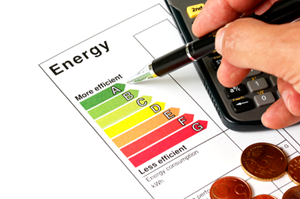 According to the US Energy Information Administration (EIA), Americans consumed 97.7 quadrillion BTU (British thermal units) of energy in 2015 alone. The major energy consumers in the US include the:
According to the US Energy Information Administration (EIA), Americans consumed 97.7 quadrillion BTU (British thermal units) of energy in 2015 alone. The major energy consumers in the US include the:
- Transportation sector (28%)
- Industrial sector (22%)
- Residential users (7%)
- Commercial users (4%)
- Energy generators (39%)
To promote energy conservation in America, the US Department of Energy (DOE) has been urging Americans to purchase and use energy-efficient appliances. This includes air conditioning system. In this article, we will discuss the differences between high efficiency air conditioners vs standard air conditioning.
Efficiency Rating (SEER)
Contents
SEER stands for Seasonal Energy Efficiency Ratio. It is a metric that is used to measure the cooling efficiency of an AC device. High efficiency air conditioners are typically assigned a high SEER ratio. Beginning Jan. 1, 2015, the EPA required all AC brands to have a minimum SEER rating of 14. Prior to this, air conditioners were only required to have a SEER rating of at least 13. This is low, considering that some modern AC units have a SEER rating of 30.
Of course, air conditioning systems with a high SEER rating tend to be more expensive than lowly rated systems. On average, every single digit improvement in SEER rating increases the cost of an air conditioner by $1,000. It is worth noting that the SEER rating is usually printed on a yellow federal Energy Guide label. It is prominently displayed on air conditioning systems.
Learn How High Efficiency Air Conditioning Works
Heat Pumps Vs. Air Conditioners
In general, heat pumps and air conditioners differ in the way they handle heat. For starters, heat pumps are designed to extract heat from a medium such as air, water or even the ground. The extracted heat can be used to heat water, buildings, or ejected outdoors. On the other hand, conventional air conditioners are designed to extract heat from indoor spaces and then eject it outdoors. According to the DOE, heat pumps can reduce energy consumption by as much as 50%. More importantly, the DOE says that a high efficiency heat pump is an excellent dehumidifier. They also claim that a high efficiency heat pump can rival the efficiency of the best air conditioner.
Heat pumps can also lower water-heating expenses per household by about $330 annually. It is worth noting that modern heat pump technology has advanced. It can now be installed in regions that experience freezing and sub-freezing temperatures for extended periods. In spite of this, the standard practice is to install heat pumps in areas that experience minimal chilly weather throughout the year. Another major difference between heat pumps and air conditioners is acquisition and installment costs.
Currently, it is cheaper to purchase and install an AC unit than a heat pump. In particular, ground-source heat pumps are installed deep underground. These systems require significant upfront investment. Luckily, some high efficiency heating systems and heat pumps qualify for tax rebates although these vary from state to state. Finally, a heat pump reverses the heat extraction process. This means that it can function as a cooling or heating system.
Updated Models & Associated Benefits
 To start with, most modern cooling systems come with cooling features aimed at improving indoor comfort. For instance, some systems come with a variable air speed adjuster. You can use this feature to improve cooling efficiency in your home without sacrificing comfort. At the same time, high efficiency air conditioners regulate humidity levels better than standard air conditioners. They achieve this goal by using a continuous air circulation mechanism. This mechanism is used instead of the intermittent cooling functionality associated with traditional AC systems.
To start with, most modern cooling systems come with cooling features aimed at improving indoor comfort. For instance, some systems come with a variable air speed adjuster. You can use this feature to improve cooling efficiency in your home without sacrificing comfort. At the same time, high efficiency air conditioners regulate humidity levels better than standard air conditioners. They achieve this goal by using a continuous air circulation mechanism. This mechanism is used instead of the intermittent cooling functionality associated with traditional AC systems.
One of the main problems associated with AC systems that rely on/on-off cycling is they are prone to injecting extremely cold bursts of air indoors when they start running. This, in turn, degrades the comfort of residents. In comparison, the design of high efficiency units provide minimal variation in indoor temperature. Another benefit of installing an updated and more efficient AC is lower risk of breakdowns. This is largely because high efficiency units are not prone to the wear and tear risks associated with on-off cycling. In the same vein, homeowners who install updated air conditioners benefit from lower maintenance costs. Besides this, modern ductless AC systems can cool indoor spaces efficiently with or without a duct network.
Air conditioning is an important part of any modern home, and air filters are also vital to the proper functioning of AC systems.
Learn About High Efficiency AC Air Filters
Single Stage vs. Variable Speed Air Conditioning Units
All AC units come with a fan/blower that circulates air throughout the ductwork. Traditionally, air conditioners came with a single-stage motor that could either push air through the ductwork at full throttle or shut down after reaching a pre-set temperature. As a result, indoor temperatures may begin to rise after the shutoff until they reach another pre-set level, triggering the AC to turn on and begin to pump cold air indoors again. This cycling is energy inefficient and may cause uneven room temperatures as well.
To solve this problem, some manufacturers introduced two-stage AC units. These units have a fan/blower that can operate at a high-speed setting and low-speed setting as well. This enabled cooling units to circulate air at full throttle and shift to a low speed setting whenever necessary. This eliminated cold and hot spots to some extent without compromising energy efficiency.
In recent years, players in the HVAC industry have introduced products that rely on a variable speed fan/blower to circulate air. Variable speed is a term that means the AC’s motor adjusts to run at different speeds. Therefore, this eliminates the cycling problem associated with single and two-stage cooling systems. Some cooling systems even support temperature adjustments by half a degree and even better, consume only about 1/5 of the energy consumed by single-stage AC systems. Variable speed AC units also lower the risk of indoor air pollution because they cause air to move through filter elements more frequently than single or two-stage air conditioners. The downside is these benefits translate to higher product pricing. However, the energy savings that accrue over time plus the enhanced comfort more than outweigh the initial investment.
High Efficiency Vs Standard Air Conditioning
High efficiency air conditioners are more beneficial than standard AC units. They are more energy efficient and are not prone to on-off cycling, which tends to produce a lot of noise. In addition, they enhance dehumidification and air circulation without degrading the comfort of users. Essentially, high efficiency air conditioners will reduce your home cooling costs while keeping your home far more comfortable. They will have a higher costs initially. However, you will get a great return on your investment with the reduced cooling costs.
Download our High Efficiency AC Savings Calculator
For any questions regarding your air conditioning system or for an air conditioner replacement, be sure to contact PFO Heating & Air Conditioning. We specialize in all makes and models of energy efficient air conditioning units.
Contact us now at (800) 253-9001 to find out more!




